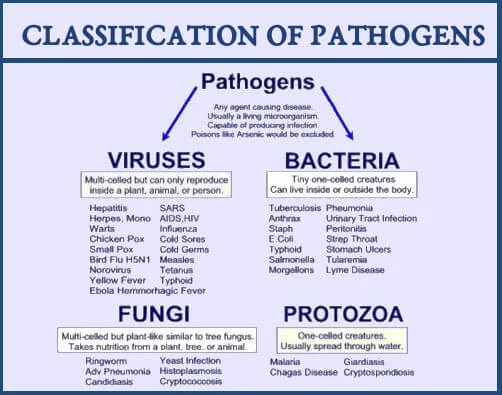Microbes or microorganisms as the name indicates are microscopic, minute, unicellular organisms. The human body is host to millions of these microbes. Some of these may cause infectious or non-infectious diseases in human beings while others are needed for our survival.
The harmful microbes that cause diseases are called pathogens or infectious agents.
The pathogens or infectious agents include bacteria, viruses, protozoa, fungi and a few variations of worms. Once they invade the host-cell, they disrupt or damage the normal cellular activities which lead to infectious chronic diseases.
Microbes enter our body through:
Microbes enter our body through:
- Respiratory tract ie, mouth and nose,
- Skin surface,
- Gastrointestinal tract (mouth oral cavity),
- Urogenital tract.
Diseases caused by Viruses:
- Study of Viruses – Virology.
- Father of Virology – Martinus Willem Beijerinck.
- In 1898, first to identify a pathogen that was smaller than a bacterium and called it "contagium vivum fluidum."
- The first person to conduct a study on virus – Dmitri Ivanowsky (1892).
Unlike other microbes, viruses have no cells of their own and they're made up of one or more molecules surrounded by a protein shell. They are inactive outside a living cell. Viruses can be seen only through an electron microscope.
Once they invade the host-cell, they take over the entire cellular activities of the organism. They cannot be easily be destroyed by the use of antibiotics.
| Disease | Virus |
|---|---|
| Covid-19* | Sars-CoV-2 |
| Nipah | Nipah Virus (Nipah henipavirus) |
| Monkey Pox | Monkeypox Virus (K.F.D. Virus) |
| Ebola | Ebola Virus (Zaire ebolavirus) |
| Chikungunya | Chikungunya virus (CHIKV) |
| Common Cold Influenza |
Rhinovirus |
| Measles | Rubeola virus |
| Mumps | Paramyxovirus (family of Rubulavirus, RNA virus) |
| Small Pox | Variola virus |
| Chickenpox Shingles |
Varicella-zoster virus |
| Rabies | Rabies virus (Rhabdoviridae family) |
| AIDS | Human Immunodeficiency Virus (HIV) |
| Herpes | Herpes Simplex Virus (HSV) |
| Dengue fever | Dengue virus |
| Severe Acute Respiratory Syndrome (SARS) |
SARS-associated coronavirus (SARS-CoV) |
| Viral encephalitis | Rabies virus, Herpes simplex, Poliovirus, Measles virus & JC virus |
| German measles | Rubella |
| Warts | Human papillomavirus (HPV) |
Diseases caused by Bacteria:
Cholera, typhoid, tuberculosis, anthrax, etc are caused by bacteria. These bacterial infections can be killed by antibiotics.
Following is the list of diseases caused by the bacteria and their pathogen.
Following is the list of diseases caused by the bacteria and their pathogen.
| Disease | Bacteria |
|---|---|
| Anthrax | Bacillus anthracis |
| Botulism | Clostridium botulinum |
| Cholera | Vibrio cholera |
| Diphtheria | Corynebacterium diphtheriae |
| Leprosy | Mycobacterium leprae |
| Leptospirosis / Rat Fever | Leptospira |
| Lyme disease | Borrelia burgdorferi |
| Gonorrhea | Neisseria gonorrhoeae |
| Peptic ulcers | Helicobacter pylori |
| Pneumonia | Streptococcus pneumonia |
| Syphilis | Treponema pallidum |
| Trachoma | Chlamydia trachomatis |
| Tetanus | Clostridium tetani |
| Typhoid | Salmonella typhi. |
| Tuberculosis | Mycobacterium tuberculosis |
| Plague | Yersinia pestis |
| Whooping Cough | Bordetella pertussis. |
Diseases Caused by Protozoans:
Protozoa are microscopic, one-celled organisms that appear in different shapes and sizes ranging from an Amoeba to Paramecium.
Some of them are parasitic in nature and cause infectious diseases.
| Disease | Protozoan |
|---|---|
| Malaria* | Plasmodium |
| Amoebic dysentery (Amoebiasis) |
Entamoeba histolytica |
| Ascariasis | Ascaris lumbricodes (roundworm) |
| Chagas' Disease (American trypanosomiasis) |
Trvpanosoma cruzi |
| Filariasis* (Elephantiasis) |
Wuchereria bancrofti
&
Wucheria malayi |
| Kala-azar* (Visceral leishmaniasis) |
Leishmania donovani |
| Sleeping sickness* (African trypanosomiasis) |
Trypanosoma brucei gambiense |
Diseases Caused by Fungi:
- Athlete’s foot – caused by the ringworm fungus known as Epidermophyton floccosum.
- Madura foot – Maurella Mycetomi.
Disease Caused by Worms:
- Filariasis: It is caused by a thread roundworms of the Filarioidea type.
- Pinworm: It is caused by a small, thin, white roundworm called Enterobiusvermicularis.
- Tapeworm: They are intestinal parasites. It cannot live on its own. It survives within the intestine of an animal including a human.
📝
SideNotes:
- Coronavirus named after its shape which is in the form of a crown with protrusions around it is a family of viruses that can cause a range of illnesses in humans including the common cold and more severe forms like SARS and MERS.
- Covid 19 – The number 19 stands for 2019, the year it emerged.
- Viral encephalitis – inflammation of the brain.
- AIDS was first reported in – USA (1981).
- The first case of HIV/AIDS in India was reported in – Chennai (1986).
- The first case of HIV/AIDS in Kerala was reported in – Pathanamthitta district (1987).
- Malaria is caused by different species of Plasmodium, among them, the most malignant and fatal malaria is caused by Plasmodium falciparum. It is spread by Anopheles mosquitoes.
- Incubation period for malaria is about – 10 days. (Additional Director, Kerala Sports & Youth Affairs, 2023)
- Filariasis is spread by female Culex mosquitoes.
- Kala-azar is spread by bites from female phlebotomine sandflies.
- Sleeping sickness is transmitted by the tsetse fly (Glossina species) found in Africa.
- February 10 – National Deworming Day.
Thanks for reading!!!









Post a Comment
Post a Comment